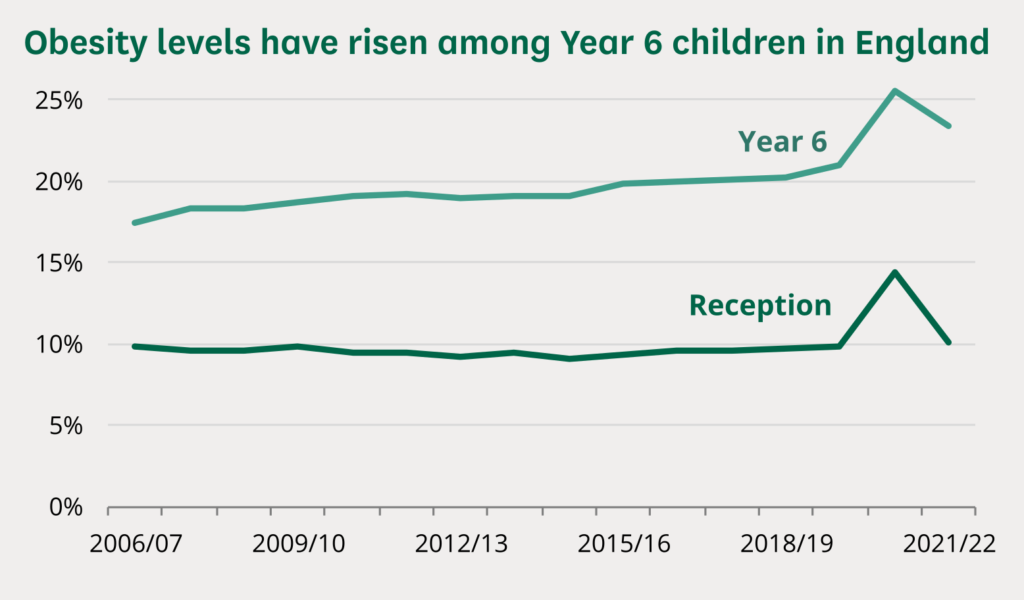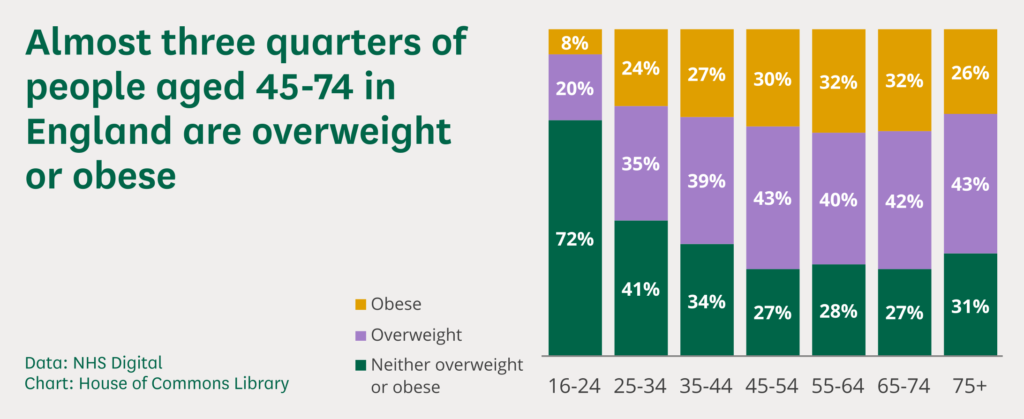Do we have lazy children?
We have an epidemic of lazy children. Are you aware of the pervasive claims like these circulating in the media? While this may be a widespread perception, it begs the question: is it a factual representation of reality? In this post, I will thoroughly examine this issue and provide actionable solutions for meaningful change. Together, let us delve deeper into this matter to gain a comprehensive understanding.
Obesity
First, let’s look at the statistics on obesity as these present objective measures and are easier to quantify and track over time. Luckily for us, this data is published by different countries. We’ll use UK, USA and WHO data to triangulate the trend. If obesity rates are high in children and if they are increasing over time then it can be one piece of evidence to (sort of) justify the headline.
UK data

- 10.1% of reception age children (age 4-5) were obese in 2021/22, with a further 12.1% overweight.
- At age 10-11 (year 6), 23.4% were obese and 14.3% overweight. (This data is gathered as part of the National Child Measurement Programme and published by NHS Digital.)
- Compared to adults The Health Survey for England 2021 estimates that 25.9% of adults in England are obese and a further 37.9% are overweight but not obese. Obesity is usually defined as having a body mass index (BMI) of 30 or above. BMI between 25 and 30 is classified as ‘overweight’.
- Trend in UK seems to be that the older you get, higher your risk becomes of being overweight and obese. It seems that this problem is not exclusive to children! Perhaps us adults must take bigger share of the blame in this.

USA data
Childhood obesity is a serious problem in the United States, putting children and adolescents at risk for poor health. For children and adolescents aged 2-19 years in 2017-2021:
- The prevalence of obesity was 19.7% and affected about 14.7 million children and adolescents.
- Obesity prevalence was 12.7% among 2- to 5-year-olds, 20.7% among 6- to 11-year-olds, and 22.2% among 12- to 19-year-olds. Childhood obesity is also more common among certain populations.
Worldwide data
- In 2016, more than 1.9 billion adults, 18 years and older, were overweight. Of these over 650 million were obese.
- Most of the world’s population live in countries where overweight and obesity kills more people than underweight.
- In 2016, 39% of adults aged 18 years and over (39% of men and 40% of women) were overweight.
- Overall, about 13% of the world’s adult population (11% of men and 15% of women) were obese in 2016.
- The worldwide prevalence of obesity has nearly tripled between 1975 and 2016.
- 39 million children under the age of 5 were overweight or obese in 2020.
- Over 340 million children and adolescents aged 5-19 were overweight or obese in 2016.
It is crystal clear from the three datasets above that overweight and obesity levels are high across the world. Looking at children, this varies from (overweight/obese) 14/23% in UK to 22% obesity in USA. This equates to almost a quarter (yes 1/4) of children in UK or USA.
Comparing these shocking numbers to adults make them even more cringe worthy. 37.9/25.9% of adults in UK and worldwide estimates suggest 1.9 billion (yes billion) adults are overweight and of these 650 million, obese! We can safely say that child overweight and obesity rates are terrible but rates for adults are far worse.
Are children lazy though?
Indirectly speaking, we can deduce form obesity rates that there may be some truth to children being lazy. After all, being overweight is mostly an equation of calories intake vs calories spent on activities. Ofcourse, there are more variables to this equation like metabolic rate, some medical illnesses but for our purpose, it is a good enough and reliable model.
But…. being overweight doesn’t necessarily mean being lazy, does it?
You may be right in having such a thought. In this post pandemic world where schools were closed for over a year and outdoor activities limited, one could be very busy and productive indeed, and still not burn enough calories to avoid weight gain. Being lazy is also subjective. What does it exactly mean and are there any statistics to understand this further?
Evidence for children being lazy?
Research suggests that in the past, children were generally more active due to fewer technological distractions and greater access to outdoor spaces. Parents may also play a role in shaping their children’s activity levels through their own behaviours and attitudes towards physical activity. Is there any evidence to confirm this?
8 years olds survey
One broad piece of evidence from across the world is International survey of children’s well-being. It asked a large number of questions to 8 years olds in different countries to gather insights into their life and wellbeing. When we look at laziness, about 19% reported rarely or never, or less than once a week doing homework. About 24% reported the same metrics for helping around the home. 18% reported playing sports or doing exercise rarely or never, or less than once a week. It could be argued that this is evidence to confirm that about 18-24% of children are lazy in the UK. That’s almost a quarter! This data is a few years old and the trend could be worse by now. This narrative however does not tell us the reasons for such poor scores in the UK.
Over 17% were unhappy with not being listened to by adults in general. Over 10% did not feel safe.
15% of children reported not being happy with ‘your relationships with people in general’ on 2013-15 worldwide children’s survey.
About 11% reported not talking at all or only once or twice a week together with their family while about 15% reported not at all or once or twice a week having fun together with family.
When looking at spending time with friends, about 27% reported not at all or once or twice a week talking together with friends. This was the same number when looking at having fun together with friends.
Over 26% were not satisfied with the outdoor areas children can use in their area. Almost 10% were unhappy with what they did in their free time.
About 22 % reported not at all or a little on ‘I like going to school. 16.1% of children were not happy with their relationship with teachers. Over 15% were not satisfied with their school experience.
Is it fair to blame children when most of the factors that make them happy, active and safe are not being provided by us adults? It isn’t helpful to label children as lazy as we are the ones that are failing them as a society.
Reasons
Studies have shown that children are not inherently lazy, but rather may lack opportunities or motivation to engage in physical activity. Factors such as increased screen time, lack of access to safe outdoor spaces, and busy schedules may contribute to a sedentary lifestyle. For example, with remote learning becoming more common, children are spending more time in front of screens for educational purposes, as well as for entertainment. While this has provided some benefits, it has also led to a decrease in physical activity.
Additionally, children in urban areas may not have access to safe outdoor spaces to play, or parents may not have the time or resources to take them to parks or other recreational areas. This can lead to a lack of motivation to engage in physical activity, as well as a lack of opportunity. In the past children were often encouraged to play outside, and this was seen as an important part of their development. This has changed due to concerns about child safety and presence of traffic on roads.
Are lazy children just a reflection of their parents?
Parents do play a role in shaping their children’s activity levels through their own behaviours and attitudes towards physical activity. Children are more likely to be active if they see their parents engaging in physical activity and prioritising it as an important part of their daily routine.
Adult obesity rates are higher than children’s. As adults, we need to lead by example if we are to change children’s obesity and activity levels.
Lack of physical activity can lead to a variety of health problems, including obesity, heart disease, and diabetes. Encouraging children to be more active through regular exercise, sports, and outdoor play can help prevent these health problems and promote overall well-being. Let’s remember, physical activity is not only beneficial for children’s physical health but also for their mental health and overall well-being.

What are the solutions?
There are several solutions to combat children’s lack of physical activity:
- As individuals, we can set a positive example through our own active lifestyles and by prioritising physical activity in our daily routines. We can incorporate some of these in the family time. This strategy alone can address concerns about children’s activity levels and provide them with the chance to talk and do activity together with their family.
- Another solution is to promote physical activity in schools by incorporating more recess time, physical education classes, and after-school sports programs.
- Parents can also encourage their children to be more active by providing opportunities for outdoor play and setting a positive example through their own active lifestyle.
- Technology can be used to promote physical activity through fitness apps or interactive games that encourage movement. For example, some schools have introduced “brain breaks” where students participate in short bursts of physical activity during class time.
- Finally, community initiatives such as building more parks and safe outdoor spaces can provide children with safe and accessible places to play and be active.
What can we do to change the situation?
Let’s take action today by:
- Setting a positive example through our own active lifestyles.
- Encouraging our children to be more active.
- Booking protected daily family time and using some of these to do fun outdoors or physical activities. This can be short time during the week and much longer on weekends.
- Advocating for policies and initiatives that promote physical activity and provide safe and accessible outdoor spaces for all children.
- Promoting physical activity in schools, encouraging active lifestyles at home, and providing safe and accessible outdoor spaces, we can help children lead happier, healthier lives.
If we do not make this a priority then the situation will only worsen and we will raise a generation of inactive, possibly lazy and obese young adults. This will not only make them unhappy but also raise the demand on mental and physical health services in the future.
